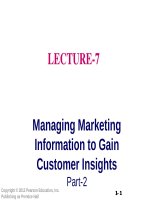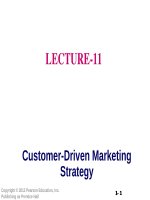Lecture Principles of Marketing - Chapter 1: Marketing - Managing profitable customer relationships
Bạn đang xem bản rút gọn của tài liệu. Xem và tải ngay bản đầy đủ của tài liệu tại đây (245.65 KB, 32 trang )
Chapter One
Marketing: Managing Profitable
Customer Relationships
Roadmap: Previewing the Concepts
1. Define marketing and the marketing
process.
2. Explain the importance of understanding
customers and identify the five core
marketplace concepts.
3. Identify the elements of a customer-driven
marketing strategy and discuss the
marketing management orientations.
4. Discuss customer relationship management
and creating value for and capturing value
from customers.
5. Describe the major trends and forces
changing the marketing landscape.
Prentice Hall, Inc. Copyright 2007
1-2
Case Study
NASCAR – What is its secret?
Creating Value
NASCAR sells the
experience – in-car
cameras, wholesome
family orientation.
NASCAR.com engages
fans via content.
Success has been
achieved by creating
lasting customer
relationships.
Capturing Value
NASCAR is the 2nd
highest rated sport on TV.
Fans are young, affluent,
and family oriented,
spending nearly $700
annually on NASCAR
merchandise.
Fans are loyal to sport
and NASCAR fans are 3
times as likely to seek out
sponsors’ products than
are nonfans.
What Is Marketing?
Simple Definition:
Marketing is managing profitable
customer relationships.
Goals:
1. Attract new customers by promising
superior value.
2. Keep and grow current customers by
delivering satisfaction.
Marketing Defined
A social and managerial process by
which individuals and groups obtain
what they need and want through
creating and exchanging products and
value with others.
OLD View
of Marketing:
Making a Sale –
“Telling & Selling”
NEW
New View
View
of
ofMarketing:
Marketing:
Satisfying
Satisfying
Customer
customerNeeds
needs
The Marketing Process
A simple model of the marketing process:
– Understand the marketplace and customer needs
and wants.
– Design a customer-driven marketing strategy.
– Construct a marketing program that delivers
superior value.
– Build profitable relationships and create customer
delight.
– Capture value from customers to create profits
and customer quality.
Needs, Wants, & Demands
Need:
State of felt deprivation including
physical, social, and individual needs.
– Physical needs:
• Food, clothing, shelter, safety
– Social needs:
• Belonging, affection
– Individual needs:
• Learning, knowledge, self-expression
Needs, Wants, & Demands
Wants:
Form that a human need takes, as
shaped by culture and individual
personality.
Wants + Buying Power = Demand
Need / Want Fulfillment
Needs and wants are fulfilled through a
Marketing Offer:
– Some combination of products, services,
information, or experiences offered to a
market to satisfy a need
or want.
Need / Want Satisfiers
Products:
– Persons
– Places
– Organizations
– Information
– Ideas
Services
– Activity or benefit
offered for sale
that is essentially
intangible and
does not result in
ownership.
Brand Experiences:
“. . . dazzle their senses, touch their hearts,
stimulate their minds.”
Marketing Myopia
Marketing myopia occurs when sellers
pay more attention to the specific
products they offer than to the benefits
and experiences produced by the
products.
They focus on the “wants” and lose
sight of the “needs.”
Value & Satisfaction
Care must be taken when setting
expectations:
– If performance is lower than expectations,
satisfaction is low.
– If performance is higher than expectations,
satisfaction is high.
Exchange vs. Transaction
Exchange:
– Act of obtaining
a desired object
from someone
by offering
something in
return.
Transaction:
– A trade of
values between
two parties.
– One party gives
X to another
party and gets Y
in return. Can
include cash,
credit, or check.
What Is a Market?
The set of actual and potential buyers
of a product.
These people share a need or want that
can be satisfied through exchange
relationships.
Modern Marketing Systems
Main elements in a modern marketing
system include:
– Suppliers
– Company (marketer)
– Competitors
– Marketing intermediaries
– Final users
Marketing Management
The art and science of choosing target
markets and building profitable
relationships with them.
– Requires that consumers and the
marketplace be fully understood
Marketing Management
Designing a winning marketing
strategy requires answers to the
following questions:
1. What customers will we serve?
What is our target market?
2. How can we best serve these
customers?
What is our value proposition?
Segmentation & Target Marketing
Market Segmentation:
– Divide the market into segments of
customers
Target Marketing:
– Select the segment to cultivate
Marketing Management
Demand
Management
– Finding and
increasing
demand, also
changing or
reducing
demand, as in
demarketing.
Demarketing
– Temporarily or
permanently
reducing the
number of
customers or
shifting their
demand.
Value Proposition
The set of benefits or values a
company promises to deliver to
consumers to satisfy their needs.
– Value propositions dictate how firms will
differentiate and position their brands in
the marketplace.
Marketing Management
Philosophies
Production Concept
Product Concept
Selling Concept
Marketing Concept
Societal Marketing Concept
The Marketing Plan
Transforms the marketing strategy into
action
Includes the marketing mix and 4 P’s of
marketing:
– Product
– Price
– Place (Distribution)
– Promotion
Customer Relationship Management
The overall process of building and
maintaining profitable customer
relationships by delivering superior
customer value and satisfaction.
– Acquiring customers
– Keeping customers
– Growing customers
Customer Perceived Value
Customer’s evaluation of the difference
between all of the benefits and all of
the costs of a marketing offer relative
to those of competing offers.
Customer Satisfaction
Dependent on the product’s perceived
performance relative to a buyer’s
expectations.
– Customer satisfaction often leads to
consumer loyalty.
– Some firms seek to DELIGHT customers
by exceeding expectations.









